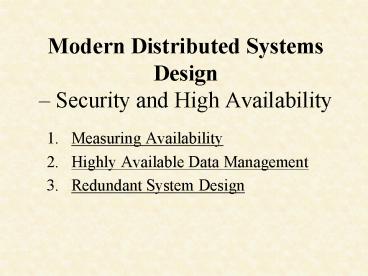Modern Distributed Systems Design - PowerPoint PPT Presentation
Title:
Modern Distributed Systems Design
Description:
Modern Distributed Systems Design Security and High Availability Measuring Availability Highly Available Data Management Redundant System Design – PowerPoint PPT presentation
Number of Views:52
Avg rating:3.0/5.0
Title: Modern Distributed Systems Design
1
Modern Distributed Systems Design Security and
High Availability
- Measuring Availability
- Highly Available Data Management
- Redundant System Design
2
Measuring Availability
- How resiliency and high availability are
interconnected? - Define downtime and what causing downtime.
- How to meager availability?
3
Measuring Availability
4
Define Downtime
- Downtime could be defined by following If a
user cannot get his job done on time, the system
is down
5
What causing downtime?
- Planned ones that easiest to reduce that
include scheduled system maintenance,
hot-swappable hard drives, cluster upgrades and
even failovers. Usually 30 of all downtime - People or human factor dumb mistakes and
complex innovation in IT equipment, software and
protocols requires greater knowledge of
engineers. Usually 15 of all downtime - Software Failures - due to software bugs and
viruses. (40)
6
How to meager availability?
- MTBF
- Availability ---------------------, where
- MTBF MTTR
- MTBF mean time between failures and MTTR -
maximum time to repair
7
What can go wrong?
- Hardware
- Environmental and Physical Failures
- Network Failures
- Database System Failures
- Web Server Failures
- File and Print Server Failures
8
The Cost of Downtime.
9
Levels of Availability
- Regular Availability
- Increased Availability
- High Availability
- Disaster recovery
- Fault-Tolerant System
10
Highly Available Data Management
- Data management is the most sensitive area of
modern distributed systems. - Quick overview of existing data topologies
11
Redundant System Design
- Redundant storage (RAID, Multi-hosting,
Multi-Pathing, DiskArray, JBOD, etc) - Failover Configurations and Management
- Introduction to SAN and Fibre Channel protocol
- Security aspects of data management in Storage
Area Networks
12
Redundant storage
13
Redundant Storage (RAID 5)
14
Failover Configurations and Management
- Failover must meet following requirements
- Transparent to client
- Quick (no more then 5 min, ideally 0-2 min)
- Minimal manual intervention, guaranteed data
access.
15
Failover components
- Two servers, one primary another takeover
- Two network connections, third is highly
recommended - All disks on a failover pair should have some
sort of redundancy - Application portability
- No single point of failure.
16
Symmetric Failover
17
Asymmetric Failover
18
Fibre Channel, SAN, IP Storage
19
Security in IP Storage Networks
- Security in Fibre Channel SANs
- Security Options for IP Storage Networks
20
Fibre Channel SAN Security
- Port or hard zoning
- WWN Zoning
- LUN Masking
21
Security Options for IP Storage Networks
- iSNS
- LUN Masking as in Fibre Channel and VLAN tagging
- IP Security or IPSec
- ACL































